Strategic Analysis: Tourism, Aged Care & Education Industries in AU
VerifiedAdded on 2023/06/13
|10
|2671
|346
Essay
AI Summary
This essay explores competitive strategies employed by organizations within the Australian tourism, aged care, and education sectors. It examines the application of Porter's Five Forces, Ansoff Matrix, and Blue Ocean Strategy using specific company examples from each industry. In the tourism sector, Cosmos Tour's potential Blue Ocean Strategy of offering tours to Antarctica is analyzed. Within the aged care industry, Royal Freemasons Coppin Centre is assessed using Porter's Five Forces to understand competitive rivalry, the threat of new entrants and substitutes, and the bargaining power of buyers and suppliers. Finally, Monash College in the education industry is evaluated through the lens of the Ansoff Matrix, focusing on market penetration, market development, product development, and diversification strategies. The essay concludes that competitive strategies are essential for organizations to differentiate themselves and achieve a sustainable competitive advantage, enabling them to generate superior returns for shareholders. Desklib provides a platform for students to access similar solved assignments and study resources.

Running head: COMPETITIVE STRATEGY
Competitive Strategy
Student’s name:
Name of the university:
Author’s note:
Competitive Strategy
Student’s name:
Name of the university:
Author’s note:
Paraphrase This Document
Need a fresh take? Get an instant paraphrase of this document with our AI Paraphraser

1COMPETITIVE STRATEGY
Table of Contents
Introduction......................................................................................................................................2
Tourism Industry in Australia..........................................................................................................2
Aged Care in Australia....................................................................................................................3
Porter’s five forces analysis.............................................................................................................4
Education industry in Australia.......................................................................................................5
Ansoff Matrix..................................................................................................................................6
Conclusion.......................................................................................................................................6
Reference List..................................................................................................................................8
Table of Contents
Introduction......................................................................................................................................2
Tourism Industry in Australia..........................................................................................................2
Aged Care in Australia....................................................................................................................3
Porter’s five forces analysis.............................................................................................................4
Education industry in Australia.......................................................................................................5
Ansoff Matrix..................................................................................................................................6
Conclusion.......................................................................................................................................6
Reference List..................................................................................................................................8

2COMPETITIVE STRATEGY
Introduction
Competitive advantage provides the organisations to have better returns on capital and
organisations take different strategies to gain the competitive advantage. As stated by Madsen
and Walker (2015), organisations want to create sustainable competitive advantage through
taking competitive strategy that can provide single attribute. In this essay, three different
industries are chosen and from each of the industry, three different organisations are selected to
show the application of competitive strategies. The aim of the essay is to show the process of
sustainable competitive strategies taken in different industries. In this essay, tourism industry,
aged care and education industry of Australia are chosen to show the competitive strategies.
Three different strategies are Ansoff Matrix, Blue Ocean Strategy and Porter's Five Forces.
Tourism Industry in Australia
Tourism in Australia can be taken as an important part of the economy of Australia. In
2016-17, tourism provided 4% of Australia’s GDP. Domestic tourism is also a significant part of
Australian tourism industry as 73% of tourism revenue comes from domestic tourism (Mistills et
al. 2017). Strengths of tourism industry in Australia lie in world class nature, safe environment
and ability to connect with world while travelling. On the contrary, weaknesses of tourism in lie
in busy destinations, expensive and all the places cover with immense distance. Opportunities in
tourism are fast growing economy in Australia and Australia government spends in tourism
infrastructure (Madsen and Walker 2015). On the other side, threats in this industry are exchange
rate and environmental destruction.
Cosmos Tour is an Australia based Tourism Company as Cosmos helps to travel the
tourists from East Coast to Eastern Europe and from Italy to the USA (Cosmosvacations.au
2018). The goal of Cosmos Australia is to make the favourite pastime for the tourists for an
affordable reality. In Australia, there are various tourism companies those are working in the
same field and offering the same types of services. Therefore, Cosmos Tour does not get enough
opportunity to increase the market share by creating a large customer base.
Blue Ocean Strategy
Introduction
Competitive advantage provides the organisations to have better returns on capital and
organisations take different strategies to gain the competitive advantage. As stated by Madsen
and Walker (2015), organisations want to create sustainable competitive advantage through
taking competitive strategy that can provide single attribute. In this essay, three different
industries are chosen and from each of the industry, three different organisations are selected to
show the application of competitive strategies. The aim of the essay is to show the process of
sustainable competitive strategies taken in different industries. In this essay, tourism industry,
aged care and education industry of Australia are chosen to show the competitive strategies.
Three different strategies are Ansoff Matrix, Blue Ocean Strategy and Porter's Five Forces.
Tourism Industry in Australia
Tourism in Australia can be taken as an important part of the economy of Australia. In
2016-17, tourism provided 4% of Australia’s GDP. Domestic tourism is also a significant part of
Australian tourism industry as 73% of tourism revenue comes from domestic tourism (Mistills et
al. 2017). Strengths of tourism industry in Australia lie in world class nature, safe environment
and ability to connect with world while travelling. On the contrary, weaknesses of tourism in lie
in busy destinations, expensive and all the places cover with immense distance. Opportunities in
tourism are fast growing economy in Australia and Australia government spends in tourism
infrastructure (Madsen and Walker 2015). On the other side, threats in this industry are exchange
rate and environmental destruction.
Cosmos Tour is an Australia based Tourism Company as Cosmos helps to travel the
tourists from East Coast to Eastern Europe and from Italy to the USA (Cosmosvacations.au
2018). The goal of Cosmos Australia is to make the favourite pastime for the tourists for an
affordable reality. In Australia, there are various tourism companies those are working in the
same field and offering the same types of services. Therefore, Cosmos Tour does not get enough
opportunity to increase the market share by creating a large customer base.
Blue Ocean Strategy
⊘ This is a preview!⊘
Do you want full access?
Subscribe today to unlock all pages.

Trusted by 1+ million students worldwide
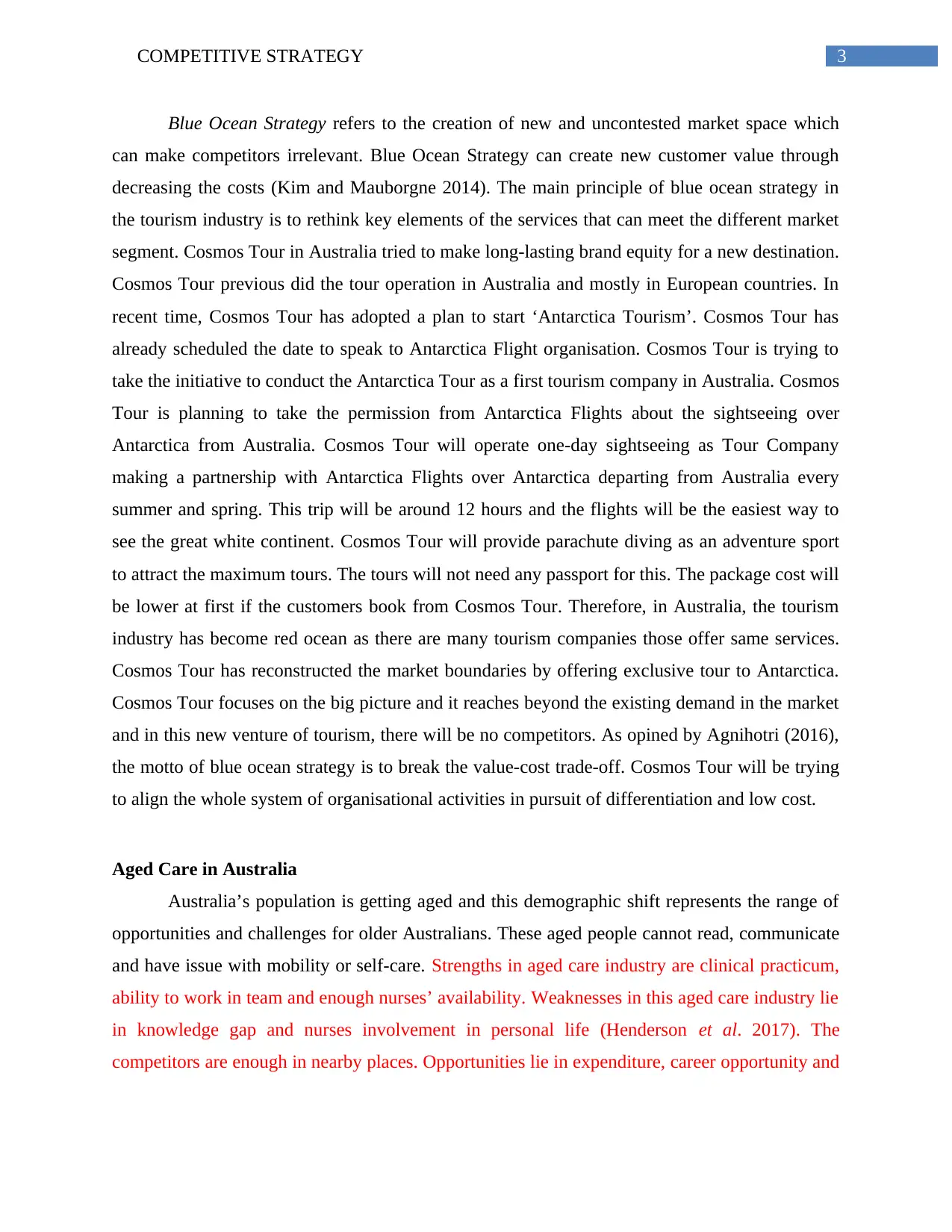
3COMPETITIVE STRATEGY
Blue Ocean Strategy refers to the creation of new and uncontested market space which
can make competitors irrelevant. Blue Ocean Strategy can create new customer value through
decreasing the costs (Kim and Mauborgne 2014). The main principle of blue ocean strategy in
the tourism industry is to rethink key elements of the services that can meet the different market
segment. Cosmos Tour in Australia tried to make long-lasting brand equity for a new destination.
Cosmos Tour previous did the tour operation in Australia and mostly in European countries. In
recent time, Cosmos Tour has adopted a plan to start ‘Antarctica Tourism’. Cosmos Tour has
already scheduled the date to speak to Antarctica Flight organisation. Cosmos Tour is trying to
take the initiative to conduct the Antarctica Tour as a first tourism company in Australia. Cosmos
Tour is planning to take the permission from Antarctica Flights about the sightseeing over
Antarctica from Australia. Cosmos Tour will operate one-day sightseeing as Tour Company
making a partnership with Antarctica Flights over Antarctica departing from Australia every
summer and spring. This trip will be around 12 hours and the flights will be the easiest way to
see the great white continent. Cosmos Tour will provide parachute diving as an adventure sport
to attract the maximum tours. The tours will not need any passport for this. The package cost will
be lower at first if the customers book from Cosmos Tour. Therefore, in Australia, the tourism
industry has become red ocean as there are many tourism companies those offer same services.
Cosmos Tour has reconstructed the market boundaries by offering exclusive tour to Antarctica.
Cosmos Tour focuses on the big picture and it reaches beyond the existing demand in the market
and in this new venture of tourism, there will be no competitors. As opined by Agnihotri (2016),
the motto of blue ocean strategy is to break the value-cost trade-off. Cosmos Tour will be trying
to align the whole system of organisational activities in pursuit of differentiation and low cost.
Aged Care in Australia
Australia’s population is getting aged and this demographic shift represents the range of
opportunities and challenges for older Australians. These aged people cannot read, communicate
and have issue with mobility or self-care. Strengths in aged care industry are clinical practicum,
ability to work in team and enough nurses’ availability. Weaknesses in this aged care industry lie
in knowledge gap and nurses involvement in personal life (Henderson et al. 2017). The
competitors are enough in nearby places. Opportunities lie in expenditure, career opportunity and
Blue Ocean Strategy refers to the creation of new and uncontested market space which
can make competitors irrelevant. Blue Ocean Strategy can create new customer value through
decreasing the costs (Kim and Mauborgne 2014). The main principle of blue ocean strategy in
the tourism industry is to rethink key elements of the services that can meet the different market
segment. Cosmos Tour in Australia tried to make long-lasting brand equity for a new destination.
Cosmos Tour previous did the tour operation in Australia and mostly in European countries. In
recent time, Cosmos Tour has adopted a plan to start ‘Antarctica Tourism’. Cosmos Tour has
already scheduled the date to speak to Antarctica Flight organisation. Cosmos Tour is trying to
take the initiative to conduct the Antarctica Tour as a first tourism company in Australia. Cosmos
Tour is planning to take the permission from Antarctica Flights about the sightseeing over
Antarctica from Australia. Cosmos Tour will operate one-day sightseeing as Tour Company
making a partnership with Antarctica Flights over Antarctica departing from Australia every
summer and spring. This trip will be around 12 hours and the flights will be the easiest way to
see the great white continent. Cosmos Tour will provide parachute diving as an adventure sport
to attract the maximum tours. The tours will not need any passport for this. The package cost will
be lower at first if the customers book from Cosmos Tour. Therefore, in Australia, the tourism
industry has become red ocean as there are many tourism companies those offer same services.
Cosmos Tour has reconstructed the market boundaries by offering exclusive tour to Antarctica.
Cosmos Tour focuses on the big picture and it reaches beyond the existing demand in the market
and in this new venture of tourism, there will be no competitors. As opined by Agnihotri (2016),
the motto of blue ocean strategy is to break the value-cost trade-off. Cosmos Tour will be trying
to align the whole system of organisational activities in pursuit of differentiation and low cost.
Aged Care in Australia
Australia’s population is getting aged and this demographic shift represents the range of
opportunities and challenges for older Australians. These aged people cannot read, communicate
and have issue with mobility or self-care. Strengths in aged care industry are clinical practicum,
ability to work in team and enough nurses’ availability. Weaknesses in this aged care industry lie
in knowledge gap and nurses involvement in personal life (Henderson et al. 2017). The
competitors are enough in nearby places. Opportunities lie in expenditure, career opportunity and
Paraphrase This Document
Need a fresh take? Get an instant paraphrase of this document with our AI Paraphraser
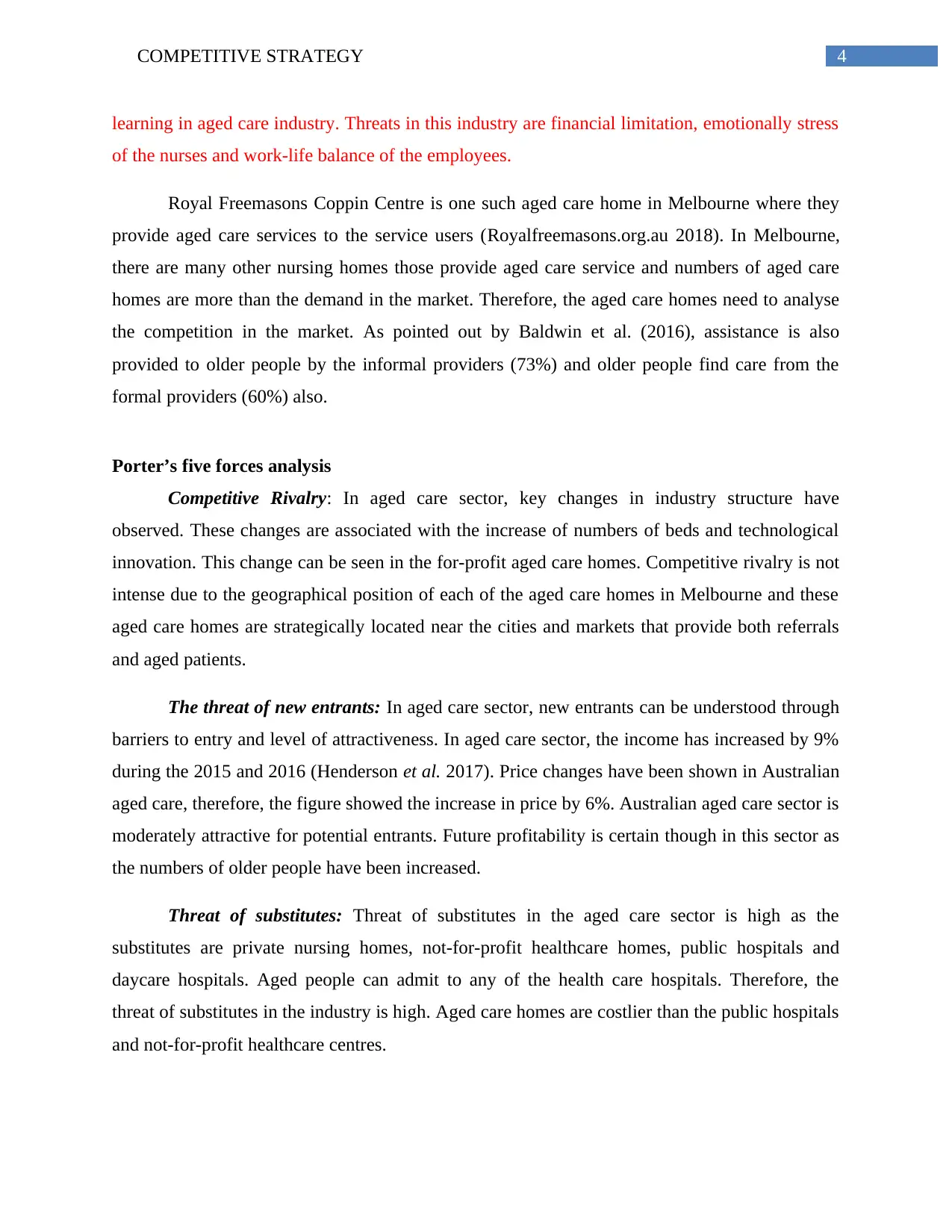
4COMPETITIVE STRATEGY
learning in aged care industry. Threats in this industry are financial limitation, emotionally stress
of the nurses and work-life balance of the employees.
Royal Freemasons Coppin Centre is one such aged care home in Melbourne where they
provide aged care services to the service users (Royalfreemasons.org.au 2018). In Melbourne,
there are many other nursing homes those provide aged care service and numbers of aged care
homes are more than the demand in the market. Therefore, the aged care homes need to analyse
the competition in the market. As pointed out by Baldwin et al. (2016), assistance is also
provided to older people by the informal providers (73%) and older people find care from the
formal providers (60%) also.
Porter’s five forces analysis
Competitive Rivalry: In aged care sector, key changes in industry structure have
observed. These changes are associated with the increase of numbers of beds and technological
innovation. This change can be seen in the for-profit aged care homes. Competitive rivalry is not
intense due to the geographical position of each of the aged care homes in Melbourne and these
aged care homes are strategically located near the cities and markets that provide both referrals
and aged patients.
The threat of new entrants: In aged care sector, new entrants can be understood through
barriers to entry and level of attractiveness. In aged care sector, the income has increased by 9%
during the 2015 and 2016 (Henderson et al. 2017). Price changes have been shown in Australian
aged care, therefore, the figure showed the increase in price by 6%. Australian aged care sector is
moderately attractive for potential entrants. Future profitability is certain though in this sector as
the numbers of older people have been increased.
Threat of substitutes: Threat of substitutes in the aged care sector is high as the
substitutes are private nursing homes, not-for-profit healthcare homes, public hospitals and
daycare hospitals. Aged people can admit to any of the health care hospitals. Therefore, the
threat of substitutes in the industry is high. Aged care homes are costlier than the public hospitals
and not-for-profit healthcare centres.
learning in aged care industry. Threats in this industry are financial limitation, emotionally stress
of the nurses and work-life balance of the employees.
Royal Freemasons Coppin Centre is one such aged care home in Melbourne where they
provide aged care services to the service users (Royalfreemasons.org.au 2018). In Melbourne,
there are many other nursing homes those provide aged care service and numbers of aged care
homes are more than the demand in the market. Therefore, the aged care homes need to analyse
the competition in the market. As pointed out by Baldwin et al. (2016), assistance is also
provided to older people by the informal providers (73%) and older people find care from the
formal providers (60%) also.
Porter’s five forces analysis
Competitive Rivalry: In aged care sector, key changes in industry structure have
observed. These changes are associated with the increase of numbers of beds and technological
innovation. This change can be seen in the for-profit aged care homes. Competitive rivalry is not
intense due to the geographical position of each of the aged care homes in Melbourne and these
aged care homes are strategically located near the cities and markets that provide both referrals
and aged patients.
The threat of new entrants: In aged care sector, new entrants can be understood through
barriers to entry and level of attractiveness. In aged care sector, the income has increased by 9%
during the 2015 and 2016 (Henderson et al. 2017). Price changes have been shown in Australian
aged care, therefore, the figure showed the increase in price by 6%. Australian aged care sector is
moderately attractive for potential entrants. Future profitability is certain though in this sector as
the numbers of older people have been increased.
Threat of substitutes: Threat of substitutes in the aged care sector is high as the
substitutes are private nursing homes, not-for-profit healthcare homes, public hospitals and
daycare hospitals. Aged people can admit to any of the health care hospitals. Therefore, the
threat of substitutes in the industry is high. Aged care homes are costlier than the public hospitals
and not-for-profit healthcare centres.

5COMPETITIVE STRATEGY
Bargaining power of buyers: In Australia, more than 9 million people aged over 40
years. Most of the Australians want to remain in their own homes when they would be aged.
Almost 5% aged Australians live in aged care homes (Wakefield et al. 2015). Customers of the
aged care homes are older people and the customers have the ability to influence the industry in a
negative way or it can damage the shareholder's interest as well. This force is moderate.
Bargaining power of suppliers: Medical practitioners, consumable medical supplies and
medical equipment sellers are the suppliers of aged care sector. This influence is not activated
positively as it has latent power to negotiate the condition to supply of the industry. This force is
low.
Education industry in Australia
The education industry has undergone a significant change over the past few years in
Australia. This change has included the introduction of new school or college funding model,
demands-driven systems, and policy initiatives and increasing the access of internet. Current
revenue in the education industry in Australia is $121 billion and annual growth is 3.5% (Verger
et al. 2016). It provides the employment of more than 800,000 and more than 19,188 educational
institutions are there in Australia (Booth and Whelan 2016). Strengths of education industry in
Australia lie in affordability value, instruction quality and programmes offering by the
institutions (Verhoven and Johnson 2017). In higher secondary sector, many foreign students
also come for studies in Australia and educational institutions try to attract the more students
with better opportunity. Weaknesses of education industry lie in the collaboration between
district and colleges, communication, process improvement. Opportunities in this industry are the
faculties, trends in education, annexation leading to better enrolment and technology. Threats are
associated to the funding restriction, high school misalignment and accountability requirement.
Monash College is one such educational institution that offers courses like Certificate in
Diplomas in art, design, architecture, arts and businesses. Monash College provides future
students visas, accommodations, airport pick-up facilities and the opening of bank account ( ).
Monash College is fully owned by Monash University and it is the path way of the international
students (Monashcollege.edu.au 2018). It has been in the industry for more than 20 years.
Bargaining power of buyers: In Australia, more than 9 million people aged over 40
years. Most of the Australians want to remain in their own homes when they would be aged.
Almost 5% aged Australians live in aged care homes (Wakefield et al. 2015). Customers of the
aged care homes are older people and the customers have the ability to influence the industry in a
negative way or it can damage the shareholder's interest as well. This force is moderate.
Bargaining power of suppliers: Medical practitioners, consumable medical supplies and
medical equipment sellers are the suppliers of aged care sector. This influence is not activated
positively as it has latent power to negotiate the condition to supply of the industry. This force is
low.
Education industry in Australia
The education industry has undergone a significant change over the past few years in
Australia. This change has included the introduction of new school or college funding model,
demands-driven systems, and policy initiatives and increasing the access of internet. Current
revenue in the education industry in Australia is $121 billion and annual growth is 3.5% (Verger
et al. 2016). It provides the employment of more than 800,000 and more than 19,188 educational
institutions are there in Australia (Booth and Whelan 2016). Strengths of education industry in
Australia lie in affordability value, instruction quality and programmes offering by the
institutions (Verhoven and Johnson 2017). In higher secondary sector, many foreign students
also come for studies in Australia and educational institutions try to attract the more students
with better opportunity. Weaknesses of education industry lie in the collaboration between
district and colleges, communication, process improvement. Opportunities in this industry are the
faculties, trends in education, annexation leading to better enrolment and technology. Threats are
associated to the funding restriction, high school misalignment and accountability requirement.
Monash College is one such educational institution that offers courses like Certificate in
Diplomas in art, design, architecture, arts and businesses. Monash College provides future
students visas, accommodations, airport pick-up facilities and the opening of bank account ( ).
Monash College is fully owned by Monash University and it is the path way of the international
students (Monashcollege.edu.au 2018). It has been in the industry for more than 20 years.
⊘ This is a preview!⊘
Do you want full access?
Subscribe today to unlock all pages.

Trusted by 1+ million students worldwide
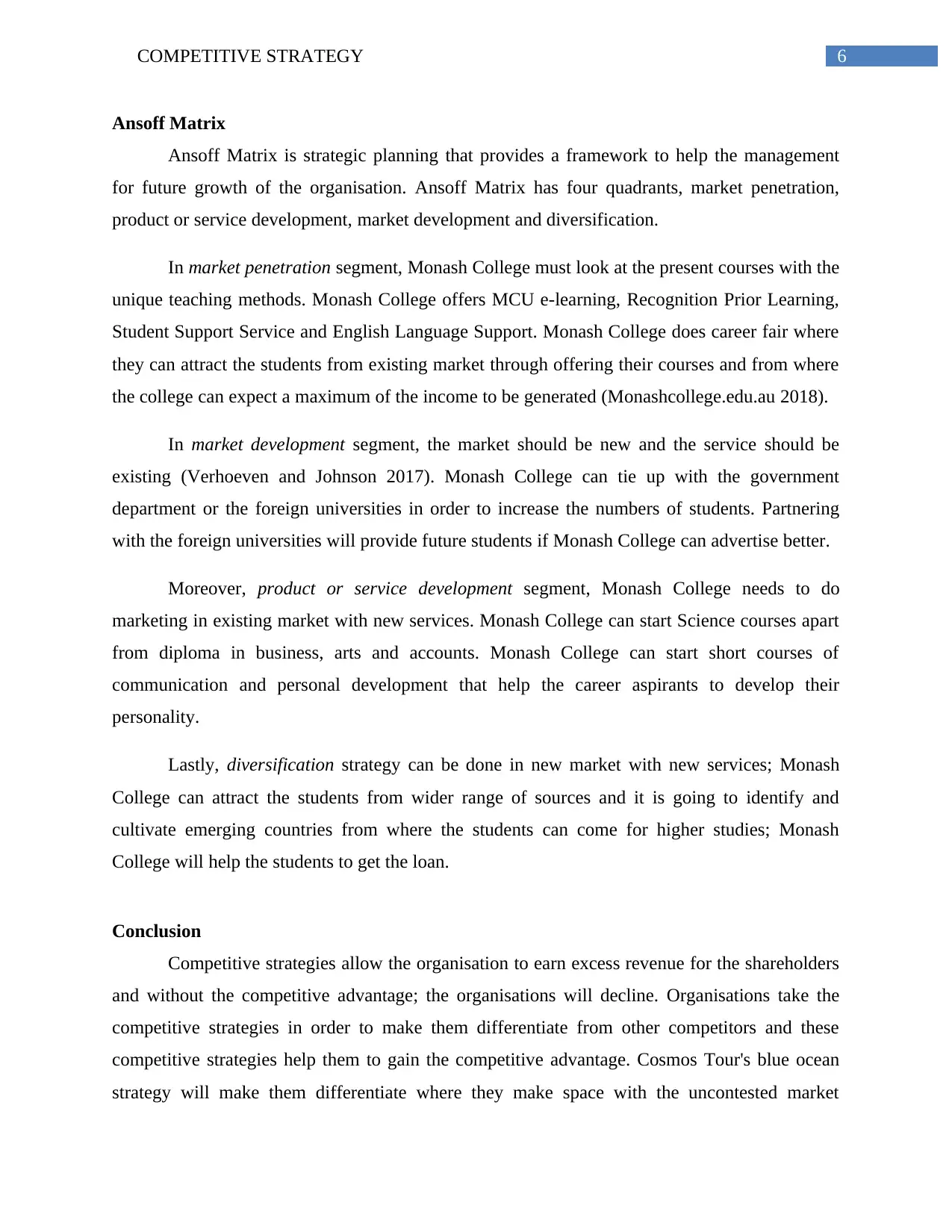
6COMPETITIVE STRATEGY
Ansoff Matrix
Ansoff Matrix is strategic planning that provides a framework to help the management
for future growth of the organisation. Ansoff Matrix has four quadrants, market penetration,
product or service development, market development and diversification.
In market penetration segment, Monash College must look at the present courses with the
unique teaching methods. Monash College offers MCU e-learning, Recognition Prior Learning,
Student Support Service and English Language Support. Monash College does career fair where
they can attract the students from existing market through offering their courses and from where
the college can expect a maximum of the income to be generated (Monashcollege.edu.au 2018).
In market development segment, the market should be new and the service should be
existing (Verhoeven and Johnson 2017). Monash College can tie up with the government
department or the foreign universities in order to increase the numbers of students. Partnering
with the foreign universities will provide future students if Monash College can advertise better.
Moreover, product or service development segment, Monash College needs to do
marketing in existing market with new services. Monash College can start Science courses apart
from diploma in business, arts and accounts. Monash College can start short courses of
communication and personal development that help the career aspirants to develop their
personality.
Lastly, diversification strategy can be done in new market with new services; Monash
College can attract the students from wider range of sources and it is going to identify and
cultivate emerging countries from where the students can come for higher studies; Monash
College will help the students to get the loan.
Conclusion
Competitive strategies allow the organisation to earn excess revenue for the shareholders
and without the competitive advantage; the organisations will decline. Organisations take the
competitive strategies in order to make them differentiate from other competitors and these
competitive strategies help them to gain the competitive advantage. Cosmos Tour's blue ocean
strategy will make them differentiate where they make space with the uncontested market
Ansoff Matrix
Ansoff Matrix is strategic planning that provides a framework to help the management
for future growth of the organisation. Ansoff Matrix has four quadrants, market penetration,
product or service development, market development and diversification.
In market penetration segment, Monash College must look at the present courses with the
unique teaching methods. Monash College offers MCU e-learning, Recognition Prior Learning,
Student Support Service and English Language Support. Monash College does career fair where
they can attract the students from existing market through offering their courses and from where
the college can expect a maximum of the income to be generated (Monashcollege.edu.au 2018).
In market development segment, the market should be new and the service should be
existing (Verhoeven and Johnson 2017). Monash College can tie up with the government
department or the foreign universities in order to increase the numbers of students. Partnering
with the foreign universities will provide future students if Monash College can advertise better.
Moreover, product or service development segment, Monash College needs to do
marketing in existing market with new services. Monash College can start Science courses apart
from diploma in business, arts and accounts. Monash College can start short courses of
communication and personal development that help the career aspirants to develop their
personality.
Lastly, diversification strategy can be done in new market with new services; Monash
College can attract the students from wider range of sources and it is going to identify and
cultivate emerging countries from where the students can come for higher studies; Monash
College will help the students to get the loan.
Conclusion
Competitive strategies allow the organisation to earn excess revenue for the shareholders
and without the competitive advantage; the organisations will decline. Organisations take the
competitive strategies in order to make them differentiate from other competitors and these
competitive strategies help them to gain the competitive advantage. Cosmos Tour's blue ocean
strategy will make them differentiate where they make space with the uncontested market
Paraphrase This Document
Need a fresh take? Get an instant paraphrase of this document with our AI Paraphraser
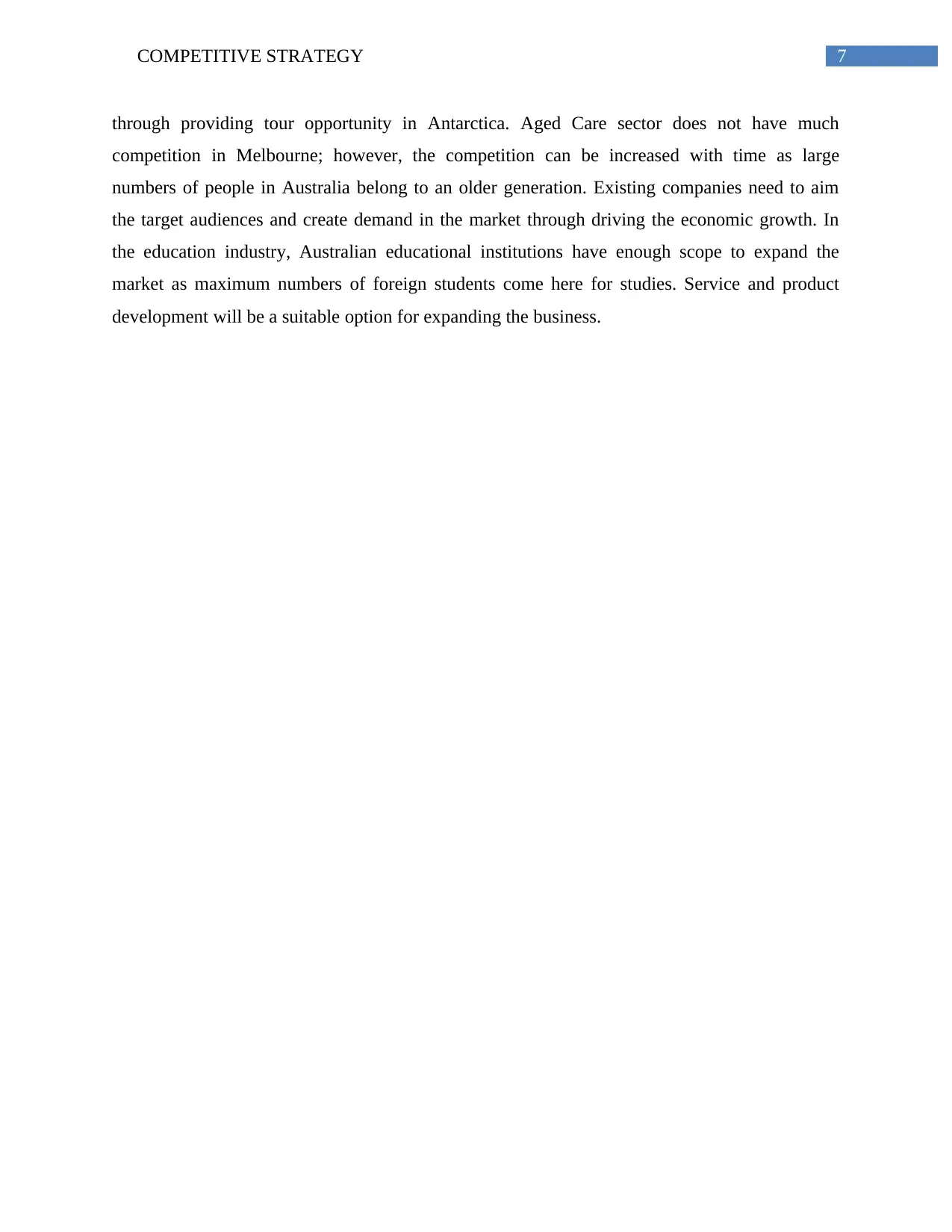
7COMPETITIVE STRATEGY
through providing tour opportunity in Antarctica. Aged Care sector does not have much
competition in Melbourne; however, the competition can be increased with time as large
numbers of people in Australia belong to an older generation. Existing companies need to aim
the target audiences and create demand in the market through driving the economic growth. In
the education industry, Australian educational institutions have enough scope to expand the
market as maximum numbers of foreign students come here for studies. Service and product
development will be a suitable option for expanding the business.
through providing tour opportunity in Antarctica. Aged Care sector does not have much
competition in Melbourne; however, the competition can be increased with time as large
numbers of people in Australia belong to an older generation. Existing companies need to aim
the target audiences and create demand in the market through driving the economic growth. In
the education industry, Australian educational institutions have enough scope to expand the
market as maximum numbers of foreign students come here for studies. Service and product
development will be a suitable option for expanding the business.
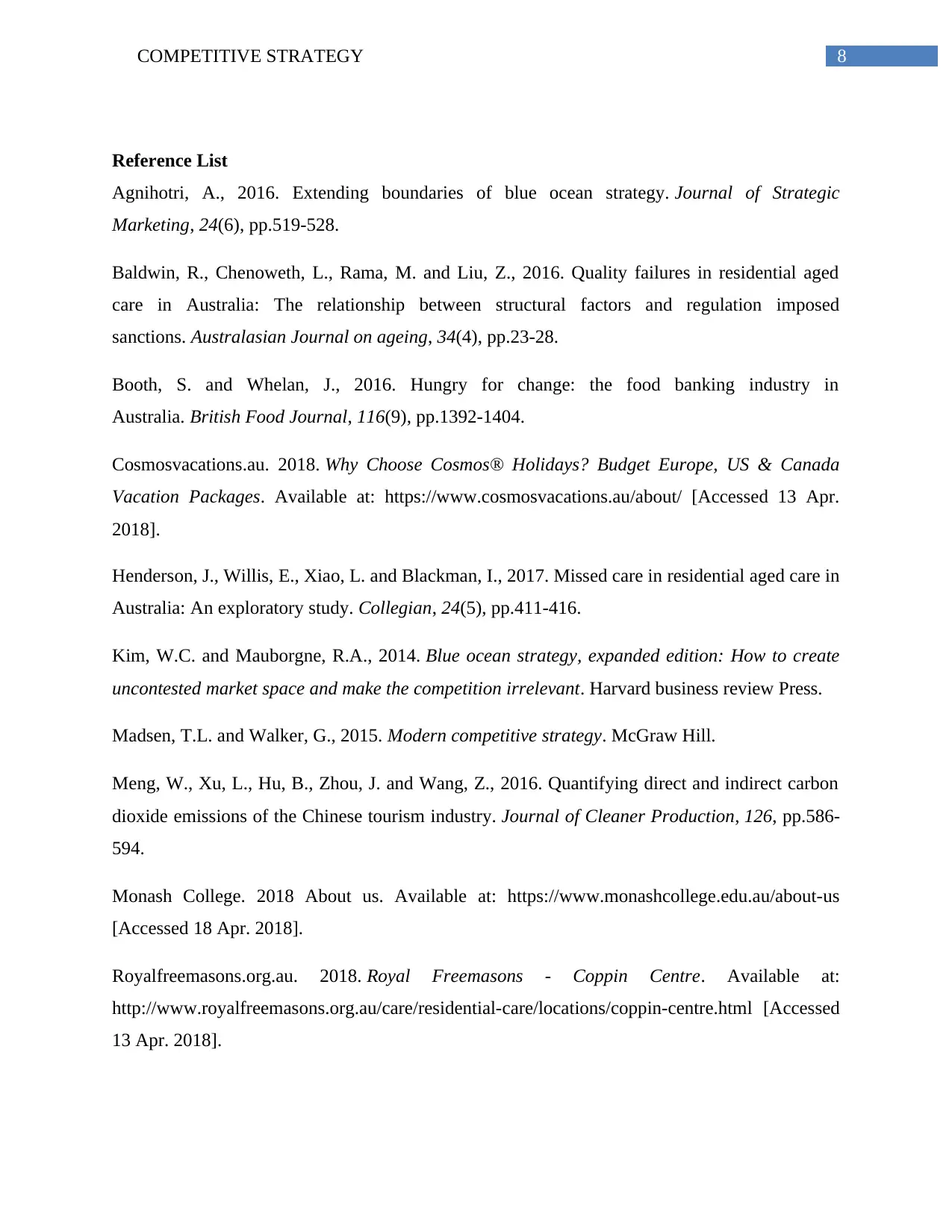
8COMPETITIVE STRATEGY
Reference List
Agnihotri, A., 2016. Extending boundaries of blue ocean strategy. Journal of Strategic
Marketing, 24(6), pp.519-528.
Baldwin, R., Chenoweth, L., Rama, M. and Liu, Z., 2016. Quality failures in residential aged
care in Australia: The relationship between structural factors and regulation imposed
sanctions. Australasian Journal on ageing, 34(4), pp.23-28.
Booth, S. and Whelan, J., 2016. Hungry for change: the food banking industry in
Australia. British Food Journal, 116(9), pp.1392-1404.
Cosmosvacations.au. 2018. Why Choose Cosmos® Holidays? Budget Europe, US & Canada
Vacation Packages. Available at: https://www.cosmosvacations.au/about/ [Accessed 13 Apr.
2018].
Henderson, J., Willis, E., Xiao, L. and Blackman, I., 2017. Missed care in residential aged care in
Australia: An exploratory study. Collegian, 24(5), pp.411-416.
Kim, W.C. and Mauborgne, R.A., 2014. Blue ocean strategy, expanded edition: How to create
uncontested market space and make the competition irrelevant. Harvard business review Press.
Madsen, T.L. and Walker, G., 2015. Modern competitive strategy. McGraw Hill.
Meng, W., Xu, L., Hu, B., Zhou, J. and Wang, Z., 2016. Quantifying direct and indirect carbon
dioxide emissions of the Chinese tourism industry. Journal of Cleaner Production, 126, pp.586-
594.
Monash College. 2018 About us. Available at: https://www.monashcollege.edu.au/about-us
[Accessed 18 Apr. 2018].
Royalfreemasons.org.au. 2018. Royal Freemasons - Coppin Centre. Available at:
http://www.royalfreemasons.org.au/care/residential-care/locations/coppin-centre.html [Accessed
13 Apr. 2018].
Reference List
Agnihotri, A., 2016. Extending boundaries of blue ocean strategy. Journal of Strategic
Marketing, 24(6), pp.519-528.
Baldwin, R., Chenoweth, L., Rama, M. and Liu, Z., 2016. Quality failures in residential aged
care in Australia: The relationship between structural factors and regulation imposed
sanctions. Australasian Journal on ageing, 34(4), pp.23-28.
Booth, S. and Whelan, J., 2016. Hungry for change: the food banking industry in
Australia. British Food Journal, 116(9), pp.1392-1404.
Cosmosvacations.au. 2018. Why Choose Cosmos® Holidays? Budget Europe, US & Canada
Vacation Packages. Available at: https://www.cosmosvacations.au/about/ [Accessed 13 Apr.
2018].
Henderson, J., Willis, E., Xiao, L. and Blackman, I., 2017. Missed care in residential aged care in
Australia: An exploratory study. Collegian, 24(5), pp.411-416.
Kim, W.C. and Mauborgne, R.A., 2014. Blue ocean strategy, expanded edition: How to create
uncontested market space and make the competition irrelevant. Harvard business review Press.
Madsen, T.L. and Walker, G., 2015. Modern competitive strategy. McGraw Hill.
Meng, W., Xu, L., Hu, B., Zhou, J. and Wang, Z., 2016. Quantifying direct and indirect carbon
dioxide emissions of the Chinese tourism industry. Journal of Cleaner Production, 126, pp.586-
594.
Monash College. 2018 About us. Available at: https://www.monashcollege.edu.au/about-us
[Accessed 18 Apr. 2018].
Royalfreemasons.org.au. 2018. Royal Freemasons - Coppin Centre. Available at:
http://www.royalfreemasons.org.au/care/residential-care/locations/coppin-centre.html [Accessed
13 Apr. 2018].
⊘ This is a preview!⊘
Do you want full access?
Subscribe today to unlock all pages.

Trusted by 1+ million students worldwide
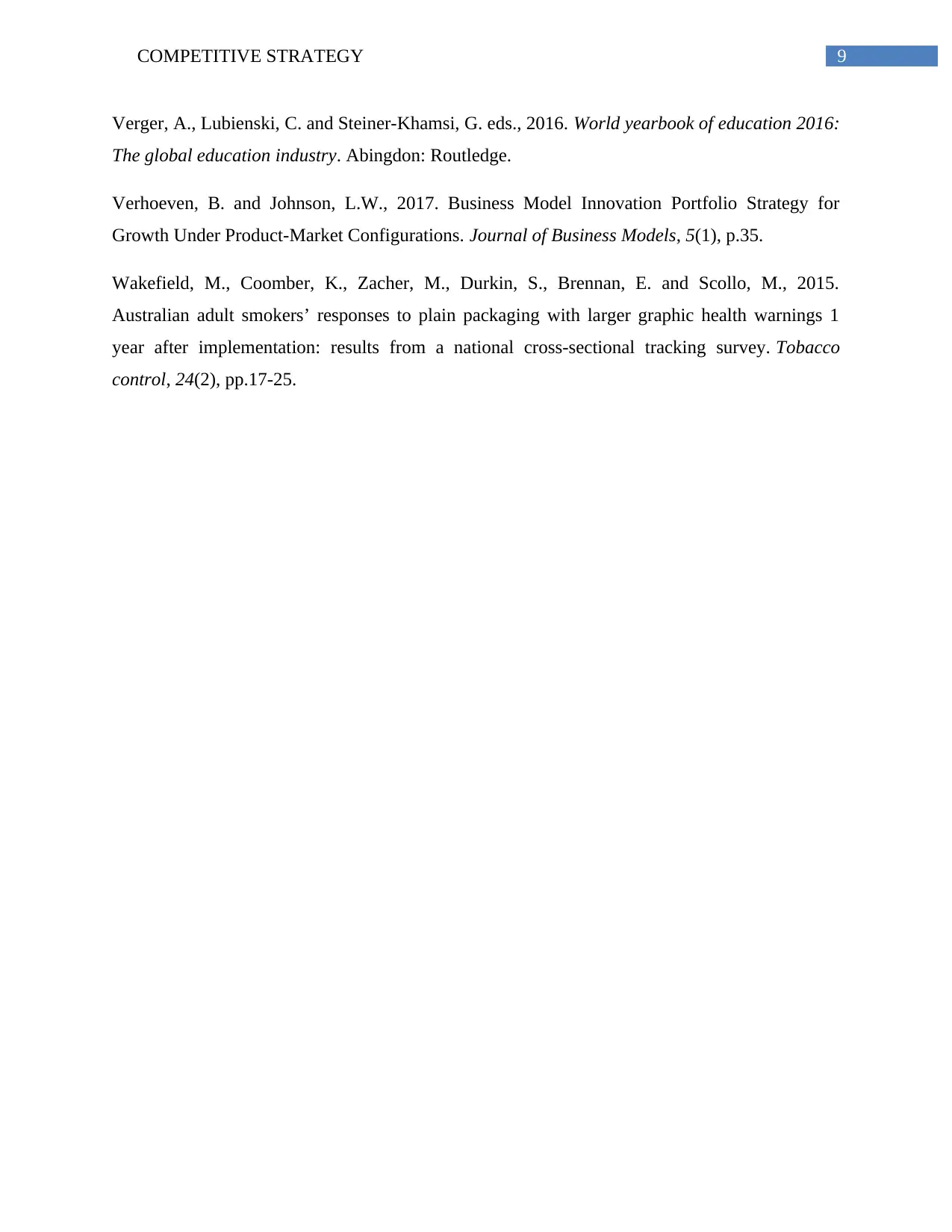
9COMPETITIVE STRATEGY
Verger, A., Lubienski, C. and Steiner-Khamsi, G. eds., 2016. World yearbook of education 2016:
The global education industry. Abingdon: Routledge.
Verhoeven, B. and Johnson, L.W., 2017. Business Model Innovation Portfolio Strategy for
Growth Under Product-Market Configurations. Journal of Business Models, 5(1), p.35.
Wakefield, M., Coomber, K., Zacher, M., Durkin, S., Brennan, E. and Scollo, M., 2015.
Australian adult smokers’ responses to plain packaging with larger graphic health warnings 1
year after implementation: results from a national cross-sectional tracking survey. Tobacco
control, 24(2), pp.17-25.
Verger, A., Lubienski, C. and Steiner-Khamsi, G. eds., 2016. World yearbook of education 2016:
The global education industry. Abingdon: Routledge.
Verhoeven, B. and Johnson, L.W., 2017. Business Model Innovation Portfolio Strategy for
Growth Under Product-Market Configurations. Journal of Business Models, 5(1), p.35.
Wakefield, M., Coomber, K., Zacher, M., Durkin, S., Brennan, E. and Scollo, M., 2015.
Australian adult smokers’ responses to plain packaging with larger graphic health warnings 1
year after implementation: results from a national cross-sectional tracking survey. Tobacco
control, 24(2), pp.17-25.
1 out of 10
Related Documents
Your All-in-One AI-Powered Toolkit for Academic Success.
+13062052269
info@desklib.com
Available 24*7 on WhatsApp / Email
![[object Object]](/_next/static/media/star-bottom.7253800d.svg)
Unlock your academic potential
Copyright © 2020–2025 A2Z Services. All Rights Reserved. Developed and managed by ZUCOL.




